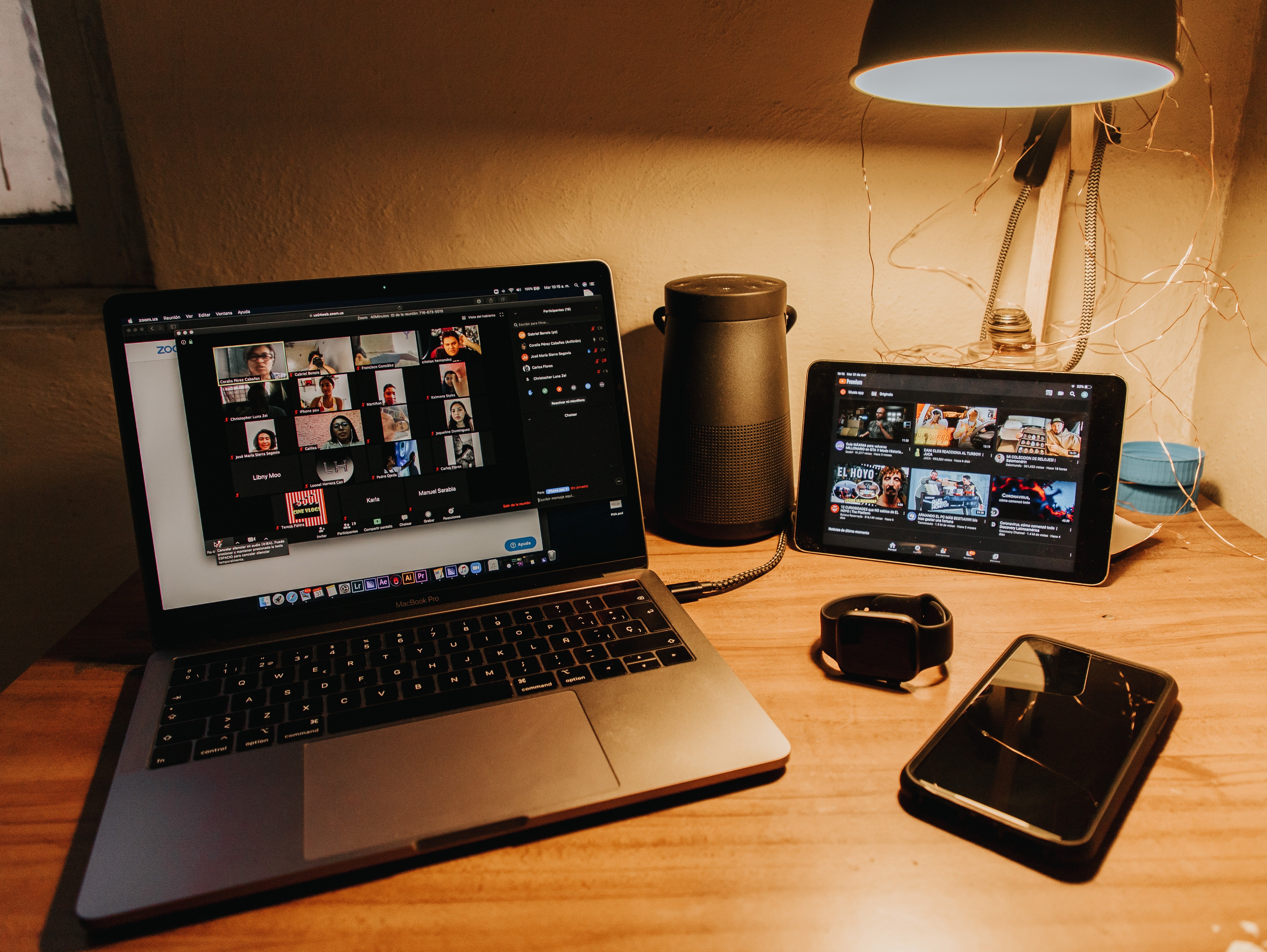
Who doesn’t love a good event? For B2B marketers, corporate events, industry trade shows and conferences are sacrosanct. For attendees, they are fruitful — and fun — business opportunities that we look forward to all year.
As the economy boomed over the past decade, so did events.
Then poof. Overnight they disappeared.
I was speaking with a colleague the first week of March, shortly after some of the earliest cases of coronavirus in the U.S. had shown up in San Francisco. She had just spent three days with 36,000 other people at San Francisco’s Moscone Center for the annual RSA conference. She felt somewhat like she had dodged a bullet. “That was just last week,” she said. “Can you imagine doing that NOW?”
Imagining it is about all we can do.
We’re Not “Scrambling”. We’re “Pivoting”.
With the spread of COVID-19 and mandatory social distancing, live events around the world have morphed into virtual experiences at lightning speed.
 We’ve seen it firsthand. We were scheduled to be in-person sponsors at SiriusDecisions Summit 2020, May 4 - 7, in Austin, Texas. Now that the event has gone digital and our team is all working from home, we’ll be manning our “booth” from our desks in Charlotte, Fort Mill, and San Francisco. (Click here to register.) Later in May, we’ll be sponsoring ITSMA’s Marketing Leadership Forum, which has also gone virtual.
We’ve seen it firsthand. We were scheduled to be in-person sponsors at SiriusDecisions Summit 2020, May 4 - 7, in Austin, Texas. Now that the event has gone digital and our team is all working from home, we’ll be manning our “booth” from our desks in Charlotte, Fort Mill, and San Francisco. (Click here to register.) Later in May, we’ll be sponsoring ITSMA’s Marketing Leadership Forum, which has also gone virtual.
As we consider what and how to prepare, we’ve been investigating other newly-virtual events for inspiration and best practices. Some organizers have made the switch seamlessly, finding new ways to entertain and engage audiences. Others are trying to find their way, struggling with virtual event software “platforms” that seemingly have not been updated since virtual events first became a thing more than a decade ago, during the Great Recession.
 Adobe Summit, which was scheduled to bring more than 20,000 people to Las Vegas in late March, went virtual, apparently without breaking a sweat. Even their Summit tagline, “The digital experience conference has gone digital,” seemed to say with a wink, “So we had to go virtual. No biggie.” Given that Adobe is in the business of helping its customers create phenomenal digital experiences, it wasn’t a stretch, though the event team and their agencies would probably strongly disagree. It also helped that Summit already had a robust digital content platform in place. Adobe’s all-digital Summit launched on March 31st, offering free registration to encourage more virtual attendees, giving them access to more than 100 breakout sessions. Adobe executives sheltering-in-place delivered keynotes from their living rooms and home offices, but the production was nonetheless impressive and refreshingly authentic; they were, quite literally, inviting attendees into their homes.
Adobe Summit, which was scheduled to bring more than 20,000 people to Las Vegas in late March, went virtual, apparently without breaking a sweat. Even their Summit tagline, “The digital experience conference has gone digital,” seemed to say with a wink, “So we had to go virtual. No biggie.” Given that Adobe is in the business of helping its customers create phenomenal digital experiences, it wasn’t a stretch, though the event team and their agencies would probably strongly disagree. It also helped that Summit already had a robust digital content platform in place. Adobe’s all-digital Summit launched on March 31st, offering free registration to encourage more virtual attendees, giving them access to more than 100 breakout sessions. Adobe executives sheltering-in-place delivered keynotes from their living rooms and home offices, but the production was nonetheless impressive and refreshingly authentic; they were, quite literally, inviting attendees into their homes.
IDC also made a successful — and last-minute — pivot to digital for its annual IDC Directions event. Originally scheduled for March 4th in the San Francisco Bay Area and March 10th in Boston, the two Directions events were combined and presented 100% online in a simple, easy-to-navigate format with pleasing production value.
But Are Virtual Events Worth It? Do They Work?
Right now, the biggest fear for event producers is that their virtual events will flop.
In other words, will people show up? Will they engage with sponsors?
In-person events dazzle captive audiences with stunning general sessions, big-name speakers and performers, networking opportunities, endless snacks, and open bars. How can you possibly compete with that online? Especially now that most people are working from home and juggling kids, pets, and an endless series of distractions?
We’re still in the early days of this unexpected shift, so there is not yet enough available evidence or data to judge whether or not virtual events will deliver the value that producers, sponsors, and attendees are seeking. However, early anecdotes from our network of customers and colleagues have left us hopeful and cautiously optimistic:
- A senior executive from one of the world’s biggest experience marketing agencies told us that virtual event attendance is exceeding expectations. He offered a theory; after weeks of sheltering-in-place, people have the desire — and plenty of time — to connect with someone other than their coworkers, families and housemates.
- The word in marketing circles is that Adobe Summit successfully attracted new attendees who appreciated being able to access an event that they would not normally have been able to attend in person.
- A senior sales executive at IDC told us that customer turnout and feedback on their Directions event was strong and positive and enabled her to have substantive follow-up conversations with many of her key accounts.
- Virtual event attendees have told us that one of the upsides of watching sessions online is the ability to seamlessly chat in real time about the content with other people in the “room”. Note to event producers: Your event platform should offer a chat feature and the ability to scroll through all participant comments, as this is one of the unique benefits that a virtual event can deliver.
- One of our customers who works at a large enterprise told us that their once ho-hum employee events have become virtual “hot tickets”. Employees love getting to make virtual visits to their top executives’ homes, where they are often treated to glimpses of their pets, their family members or even just what’s on the shelf in their home offices.
Advice For a New Normal
While we don’t have all the answers, we have learned a lot from our customers, friends and colleagues in our mad dash to figure out how to succeed in this new reality. Here’s what we know:
Production value matters
We’re all adjusting to video conferencing tools for team meetings and happy hours. But while blurry, halting Zoom calls may suffice for regular checkpoints, they won’t cut it when you’re producing an event for busy executives, especially if they are paying to attend.
In short, now is not the time for technical difficulties.
If your audience is attending your event virtually, it is critical that they be able to see and hear you. The best content in the world can’t overcome a shoddy production. That’s why we recommend you upgrade your lighting and recording equipment to make a good impression. Executives can tell the difference between a low-budget production and a professional one, and these days, it’s fairly economical to acquire everything you need to take your presentation up a notch.
 Invest in a ring light, the latest smartphone, a tripod and a microphone. Acquire a green screen or redecorate your office space so that the background looks attractive and professional. Edit the portions of your event that aren’t live to incorporate music, transitions and titles, and make sure slides, video or other content integrate seamlessly and instantly. Think about the difference between shaky iPhone footage and a well-produced video. For inspiration, watch the executive keynotes from Adobe Summit.
Invest in a ring light, the latest smartphone, a tripod and a microphone. Acquire a green screen or redecorate your office space so that the background looks attractive and professional. Edit the portions of your event that aren’t live to incorporate music, transitions and titles, and make sure slides, video or other content integrate seamlessly and instantly. Think about the difference between shaky iPhone footage and a well-produced video. For inspiration, watch the executive keynotes from Adobe Summit.
Lean into authenticity
The shared experience of social distancing is an opportunity to connect on a personal level. That holds true with virtual events, too.
The best digital experiences we’ve seen so far don’t try to pretend we’re operating in a state of normal. CEOs have appeared on camera growing a quarantine beard. Executives have chimed in from the comfort of their backyards. And it’s proven that professionalism and authenticity don’t have to be mutually exclusive.
Giving people a glimpse of your humanity adds levity to our current situation. It’s disarming for audiences. It provides an opportunity for deeper personal connection. All of that is particularly useful in selling to and engaging the C-suite.
Create a dialogue
When you host an in-person live event, you have the benefit of a captive audience. They’re in the room, eating a catered lunch and motivated to listen. If they get up to leave or mindlessly pull out their phone, it’s a faux pas.
That’s not the case with virtual events. You’re competing with the real world. Your audience could be cooking dinner or checking email for all you know. In person, it’s easy to tell if someone tunes you out. Online, it’s a mystery, but not impossible.
Soliciting questions from the audience is a great way to make the presentation feel personal to them. Ask before the event begins and throughout. Utilize event and social platforms. And establish checkpoints along the way. Live polls and chat features are great ways to engage attendees and make them feel that they are part of the conversation.
Encourage your sponsors & attendees to adjust their success metrics
A successful event is often measured in attendance. How many people stopped by your booth? How many business cards did you collect? How many meetings did you set up? With a virtual event, head count can be vague. Attendees drop in and out, and some like to watch after the fact, making it difficult to derive meaningful data to gauge the relative success of an event.
However, where there’s change, there’s opportunity. Virtual events can fit well within a long-tail strategy, and they’re an excellent way to reach markets that are otherwise unattainable. Instead of focusing strictly on views, encourage your sponsors and attendees to look to conversions, instead. You may come away from a virtual event with fewer tangible connections — face-to-face conversation is a tough thing to beat — but you will come away with something to show for your efforts. The trick is not to judge the success of a virtual event in the same way you would a live one. Be flexible, nimble and open to the newness of the experience.
Offer up your experts and executives
“Ask the experts” and executive-to-executive meetings are among the most popular features of live events. This is easy enough to pull off virtually since you don’t have to worry about meeting rooms, catering or people getting lost. Build time into the agenda for your top customers — or all of your customers, if you can — to schedule video meetings with experts, thought leaders and executives who would normally be difficult to access. This type of access is one of the best ways to deliver a personalized, relevant, and worthwhile experience to your attendees. It makes them feel important and valued and it provides your company with meaningful face time with customers, which is what events are all about.
Don’t forget the fun
 In our current crisis, people from all over the world are coping with humor and creativity and sharing their genius online. People are running full marathons within the confines of balconies and gardens with thousands of online viewers cheering them on. An idle BBC sports commentator is calling play-by-plays of his dogs’ daily routines, perhaps reaching and entertaining more people than ever before. Actors, comedians, musicians, and other celebrities are using their talents to delight people around the world virtually. Dave Matthews performed a live acoustic set from the garage of his Seattle home and streamed it live online. John Krasinski, of “The Office” fame, has launched his own news show highlighting all the good in the world. The title? “Some Good News”. With a sign made by his daughters as his backdrop, Krasinski's first guest was none other than Michael Scott himself, Steve Carell.
In our current crisis, people from all over the world are coping with humor and creativity and sharing their genius online. People are running full marathons within the confines of balconies and gardens with thousands of online viewers cheering them on. An idle BBC sports commentator is calling play-by-plays of his dogs’ daily routines, perhaps reaching and entertaining more people than ever before. Actors, comedians, musicians, and other celebrities are using their talents to delight people around the world virtually. Dave Matthews performed a live acoustic set from the garage of his Seattle home and streamed it live online. John Krasinski, of “The Office” fame, has launched his own news show highlighting all the good in the world. The title? “Some Good News”. With a sign made by his daughters as his backdrop, Krasinski's first guest was none other than Michael Scott himself, Steve Carell.
This is the time to lean on your agency partners and creatives. Challenge them to bring this same kind of can-do spirit and ingenuity to your virtual events. More than ever, people want to be entertained, and they want to connect with others, enjoy a few light-hearted moments, laugh, and have fun. If you can deliver all of that at this difficult time, your attendees will be grateful, your event will be memorable and your brand will benefit.
Do good
This is a time where it benefits businesses in all kinds of powerful ways to think beyond their bottom line. To that end, consider incorporating a philanthropic component to your virtual event.
Some in-person events have already built this into their business model, asking attendees to donate money or assemble school backpacks for donation while they are on site. With virtual events, the hands-on component may be off the table, but there are plenty of other ways to make an impact. Select a nonprofit or disaster relief fund to contribute to and collect online donations. Build donations into ticket prices, letting attendees know that with each ticket purchased, you’ll donate a meal to children in need. Chances are, your attendees are eager to give back. When you offer them a way to do that, you make it easy for them to make a difference. Everyone wins.
Above all, stay organized
Online events aren’t perfect. Humans often rely on social cues, and virtual events can hamper non-verbal communication. Then there’s the looming threat of Internet connectivity issues, which can zap momentum and energy like nobody’s business.
That means preparation will be paramount. Define your talking points clearly. Have a plan for who is speaking and what you want to cover. Ensure your virtual “booth” is staffed throughout the day to catch anyone who might wander in. And enjoy yourself. We’re lucky to live in a time in which technology can help us rise to the challenge of the digital event. In this new normal, let’s take full advantage of the opportunities that await.






Share Your Thoughts